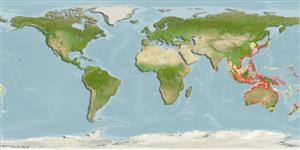Environment: milieu / climate zone / depth range / distribution range
Ecologia
marino; salmastro benthopelagico. Tropical
Western Pacific: Taiwan Strait (Ref. 47843), eastern Australia (Ref. 7300) and Papua New Guinea (Ref. 6192).
Size / Peso / Age
Maturity: Lm ? range ? - ? cm
Max length : 15.0 cm TL maschio/sesso non determinato; (Ref. 3131)
Adults occur inshore. Omnivorous species (Ref. 7300). Eggs are guarded and fanned by the male parent (Ref. 205).
Life cycle and mating behavior
Maturità | Riproduzione | Deposizione | Uova | Fecundity | Larve
Paxton, J.R., D.F. Hoese, G.R. Allen and J.E. Hanley, 1989. Pisces. Petromyzontidae to Carangidae. Zoological Catalogue of Australia, Vol. 7. Australian Government Publishing Service, Canberra, 665 p. (Ref. 7300)
IUCN Red List Status (Ref. 130435: Version 2024-1)
Threat to humans
Harmless
Human uses
Strumenti
Special reports
Download XML
Fonti Internet
Estimates based on models
Preferred temperature (Ref.
123201): 22.4 - 29, mean 28.1 °C (based on 886 cells).
Phylogenetic diversity index (Ref.
82804): PD
50 = 1.0000 [Uniqueness, from 0.5 = low to 2.0 = high].
Bayesian length-weight: a=0.01288 (0.00590 - 0.02812), b=3.04 (2.86 - 3.22), in cm total length, based on LWR estimates for this (Sub)family-body shape (Ref.
93245).
Trophic level (Ref.
69278): 2.0 ±0.00 se; based on food items.
Resilienza (Ref.
120179): Alto, tempo minimo di raddoppiamento della popolazione meno di 15 mesi (Preliminary K or Fecundity.).
Fishing Vulnerability (Ref.
59153): Low vulnerability (10 of 100).
Nutrients (Ref.
124155): Calcium = 204 [129, 416] mg/100g; Iron = 1.27 [0.78, 2.14] mg/100g; Protein = 17.3 [16.4, 18.2] %; Omega3 = 0.244 [0.126, 0.457] g/100g; Selenium = 53.3 [27.2, 109.4] μg/100g; VitaminA = 29.5 [11.0, 76.4] μg/100g; Zinc = 2.74 [1.96, 3.82] mg/100g (wet weight);
